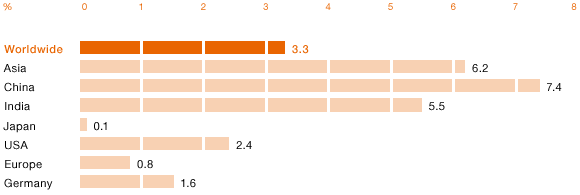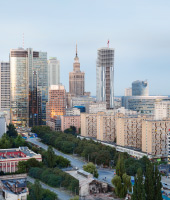Economic Trends
The conflict between Russia and Ukraine and the associated economic sanctions imposed by the USA and EU weighed on global economic growth. The situation in the Middle East has impacted economic activity as well. Although 2014 started out strongly, economic clouds gathered as the year progressed. In the eurozone, growth was weaker than expected, but did rise slightly for the first time in two years. The US economy continued to recover.
The International Monetary Fund (IMF) estimates that the world economy grew 3.3 percent in 2014 (2013: 3.3 percent). Originally, the IMF had expected growth of 3.7 percent.
GDP Trends in 2014

Sources – worldwide: IMF; Asia: ADB; China: National Development and Reform Commission; India: ADB; Japan: IMF; USA: IMF; Europe: IMF; Germany: Federal Statistics Office
Stable Growth in Asia
In 2014, Asia remained on its stable growth path. The Asian Development Bank (ADB) expects GDP expansion of 6.2 percent (2013: 6.1 percent). Even though growth in China slowed down slightly, the country continues to play a key part in driving the region’s economy. According to the National Development and Reform Commission, China’s economy grew by 7.4 percent (2013: 7.7 percent). The new Indian government started to introduce major structural reforms to leverage growth potential more effectively. This brought about a change in sentiment. As a result, India’s GDP expanded more strongly than in the previous year, according to ADB estimates. It climbed 5.5 percent (2013: 4.7 percent). Higher consumption taxes impacted the Japanese economy, particularly in the second half of the year. Based on IMF forecasts, Japan’s GDP grew only 0.1 percent (2013: 1.6 percent).
US Economy in Good Shape
The US economy performed robustly during 2014. While the long winter meant that the year got off to a subdued start, the economy picked up momentum as the year progressed. Unemployment dropped further, and investing activities stayed at a high level. Due to the economic revival, the American Federal Reserve gradually scaled back its purchase of US government bonds. According to the IMF, GDP rose by 2.4 percent (2013: 2.2 percent).
Eurozone Sees Slight Growth for First Time in Two Years
The eurozone economy expanded for the first time in two years, even though the growth rate was less than originally forecast. According to IMF calculations, GDP within the EU rose 0.8 percent (2013: -0.5 percent). In spite of this slight increase, Europe is still suffering from the effects of the sovereign-debt crisis, high unemployment and weak investment spending. The performance of individual EU member states varies considerably. Spain’s economy is growing once more, whereas the situation in France, Italy and Greece remains critical.
German Economic Growth Above Expectations
While the German economy expanded more strongly than in the previous year, momentum was noticeably lower than expected. Yet, Germany is still Europe’s main growth engine. The rise in GDP was chiefly due to healthy domestic demand. Business analysts, however, criticize the German government for sending the wrong economic signals by burdening companies excessively through reforms relating to the introduction of a minimum wage, retirement at 63, and additional pension entitlements mainly for mothers of children born before 1992. Instead, these analysts demand that more should be invested in infrastructure, education and R&D. Data issued by the German Federal Statistics Office show that GDP increased by 1.6 percent (2013: 0.4 percent).



